Silica- and Sulfur-Rich Deposits Preserving Microbial Signatures at Zannone Hydrothermal Field, Western Mediterranean Sea
Abstract
1. Introduction
Geological Background and Hydrothermal Activity of the Zannone Giant Pockmark (ZGP)
2. Materials and Methods
2.1. Sample Collection and Processing
2.2. X-Ray Powder Diffraction, Chemical, and Isotope Analyses
2.3. Scanning Electron Microscopy (SEM-EDS)
3. Results
3.1. Zannone Crusts: Morphology and Distribution
3.2. Mineral-Chemical Analyses
3.3. δ34S Dissolved Sulfur Analysis
3.4. Zannone Crusts: Biological Evidence
4. Discussion
4.1. Interpretation and Formation Processes of the ZGP Crusts
4.2. Silicification Pattern of the Mat
4.3. Sulfur Precipitation Process
5. Conclusions
Supplementary Materials
Author Contributions
Funding
Data Availability Statement
Acknowledgments
Conflicts of Interest
Abbreviations
| ZGP | Zannone Giant Pockmark |
| EPSs | Extracellular Polymeric Substances |
References
- Martin, W.; Baross, J.; Kelley, D.; Russell, M.J. Hydrothermal vents and the origin of life. Nat. Rev. Microbiol. 2008, 6, 805–814. [Google Scholar] [CrossRef]
- López-García, P.; Kazmierczak, J.; Benzerara, K.; Kempe, S.; Guyot, F.; Moreira, D. Bacterial diversity and carbonate precipitation in the giant microbialites from the highly alkaline Lake Van, Turkey. Extremophiles 2005, 9, 263–274. [Google Scholar] [CrossRef]
- Dick, G.J. The microbiomes of deep-sea hydrothermal vents: Distributed globally, shaped locally. Nat. Rev. Microbiol. 2019, 17, 271–283. [Google Scholar] [CrossRef]
- Burne, R.V.; Moore, L.S. Microbialites: Organosedimentary deposits of benthic microbial communities. Palaios 1987, 2, 241–254. [Google Scholar] [CrossRef]
- Riding, R. Classification of microbial carbonates. In Calcareous Algae and Stromatolites; Springer: Berlin/Heidelberg, Germany, 1991; pp. 21–51. [Google Scholar]
- Dong, H.; Huang, L.; Zhao, L.; Zeng, Q.; Liu, X.; Sheng, Y.; Shi, L.; Wu, G.; Jiang, H.; Li, F.; et al. A critical review of mineral–microbe interaction and co-evolution: Mechanisms and applications. Natl. Sci. Rev. 2022, 9, nwac128. [Google Scholar] [CrossRef]
- Douglas, S.; Beveridge, T.J. Mineral formation by bacteria in natural microbial communities. FEMS Microbiol. Ecol. 1998, 26, 79–88. [Google Scholar] [CrossRef]
- Nutman, A.P.; Bennett, V.C.; Friend, C.R.; Van Kranendonk, M.J.; Chivas, A.R. Rapid emergence of life shown by discovery of 3700-million-year-old microbial structures. Nature 2016, 537, 535–538. [Google Scholar] [CrossRef] [PubMed]
- Pepe-Ranney, C.; Berelson, W.M.; Corsetti, F.A.; Treants, M.; Spear, J.R. Cyanobacterial construction of hot spring siliceous stromatolites in Yellowstone National Park. Environ. Microbiol. 2012, 14, 1182–1197. [Google Scholar] [CrossRef]
- Coman, C.; Chiriac, C.M.; Robeson, M.S.; Ionescu, C.; Dragos, N.; Barbu-Tudoran, L.; Andrei, A.Ş.; Banciu, H.L.; Sicora, C.; Podar, M. Structure, mineralogy, and microbial diversity of geothermal spring microbialites associated with a deep oil drilling in Romania. Front. Microbiol. 2015, 6, 253. [Google Scholar] [CrossRef]
- Bradley, J.A.; Daille, L.K.; Trivedi, C.B.; Bojanowski, C.L.; Stamps, B.W.; Stevenson, B.S.; Nunn, H.S.; Johnson, H.A.; Loyd, S.J.; Berelson, W.M.; et al. Carbonate-rich dendrolitic cones: Insights into a modern analog for incipient microbialite formation, Little Hot Creek, Long Valley Caldera, California. npj Biofilms Microbiomes 2017, 3, 32. [Google Scholar] [CrossRef] [PubMed]
- Planavsky, N.; Ginsburg, R.N. Taphonomy of modern marine Bahamian microbialites. Palaios 2009, 24, 5–17. [Google Scholar] [CrossRef]
- Khodadad, C.L.; Foster, J.S. Metagenomic and metabolic profiling of nonlithifying and lithifying stromatolitic mats of Highborne Cay, The Bahamas. PLoS ONE 2012, 7, e38229. [Google Scholar] [CrossRef]
- Kempe, S.; Kazmierczak, J.; Landmann, G.; Konuk, T.; Reimer, A.; Lipp, A. Largest known microbialites discovered in Lake Van, Turkey. Nature 1991, 349, 605–608. [Google Scholar] [CrossRef]
- Proemse, B.C.; Eberhard, R.S.; Sharples, C.; Bowman, J.P.; Richards, K.; Comfort, M.; Barmuta, L.A. Stromatolites on the rise in peat-bound karstic wetlands. Sci. Rep. 2017, 7, 15384. [Google Scholar] [CrossRef]
- Ingrassia, M.; Conte, A.M.; Perinelli, C.; Aldega, L.; Di Bella, L.; Mazzoni, C.; Fazi, S.; Falese, F.G.; Ruspandini, T.; Piacentini, A.; et al. Experimental vs. Natural Mineral Precipitation in Modern Microbialites: The Case Study of the Alkaline Bagno Dell’acqua Lake (Pantelleria Island, Italy). Minerals 2024, 14, 1013. [Google Scholar] [CrossRef]
- Shapiro, R.S.; Awramik, S.M. Microbialite morphostratigraphy as a tool for correlating Late Cambrian–Early Ordovician sequences. J. Geol. 2000, 108, 171–180. [Google Scholar] [CrossRef]
- Golubic, S.; Hofmann, H.J. Comparison of Holocene and mid-Precambrian Entophysalidaceae (Cyanophyta) in stromatolitic algal mats: Cell division and degradation. J. Paleontol. 1976, 50, 1074–1082. [Google Scholar]
- Rice, M.S.; Bell, J.F.; Cloutis, E.A.; Wang, A.; Ruff, S.W.; Craig, M.A.; Bailey, D.T.; Johnson, J.R.; de Souza, P.A.; Farrand, W.H. Silica-rich deposits and hydrated minerals at Gusev Crater, Mars: Vis-NIR spectral characterization and regional mapping. Icarus 2010, 205, 375–395. [Google Scholar] [CrossRef]
- Rogers, E.R.; Qualizza, B.R.; Heidenreich, J.R.; Dawson, H.G.; Horgan, B.H. Silica-Bearing Mounds and Strata in the Southwest Melas Basin, Valles Marineris, Mars: Evidence for a Hydrothermal Origin. J. Geophys. Res. Planets 2023, 128, e2023JE007881. [Google Scholar] [CrossRef]
- Ruff, S.W.; Farmer, J.D. Silica deposits on Mars with features resembling hot spring biosignatures at El Tatio in Chile. Nat. Commun. 2016, 7, 13554. [Google Scholar] [CrossRef]
- Rizzo, V. Why should geological criteria used on Earth not be valid also for Mars? Evidence of possible microbialites and algae in extinct Martian lakes. Int. J. Astrobiol. 2020, 19, 283–294. [Google Scholar] [CrossRef]
- Martorelli, E.; Italiano, F.; Ingrassia, M.; Macelloni, L.; Bosman, A.; Conte, A.M.; Beaubien, S.E.; Graziani, S.; Sposato, A.; Chiocci, F.L. Evidence of a shallow water submarine hydrothermal field off Zannone Island from morphological and geochemical characterization: Implications for Tyrrhenian Sea Quaternary volcanism. J. Geophys. Res. Solid Earth 2016, 121, 8396–8414. [Google Scholar] [CrossRef]
- Ingrassia, M.; Di Bella, L.; Chiocci, F.L.; Martorelli, E. Influence of fluid emissions on shallow-water benthic habitats of the Pontine Archipelago (Tyrrhenian Sea, Italy). Alp. Mediterr. Quat. 2015, 28, 99–110. [Google Scholar]
- Ingrassia, M.; Martorelli, E.; Bosman, A.; Macelloni, L.; Sposato, A.; Chiocci, F.L. The Zannone Giant Pockmark: First evidence of a giant complex seeping structure in shallow-water, central Mediterranean Sea, Italy. Mar. Geol. 2015, 363, 38–51. [Google Scholar] [CrossRef]
- Di Bella, L.; Ingrassia, M.; Frezza, V.; Chiocci, F.L.; Martorelli, E. The response of benthic meiofauna to hydrothermal emissions in the Pontine Archipelago, Tyrrhenian Sea (central Mediterranean Basin). J. Mar. Syst. 2016, 164, 53–66. [Google Scholar] [CrossRef]
- Conte, A.M.; Di Bella, L.; Ingrassia, M.; Perinelli, C.; Martorelli, E. Alteration and Mineralization Products of the Zannone Giant Pockmark (Zannone Hydrothermal Field, Central Tyrrhenian Sea). Minerals 2020, 10, 581. [Google Scholar] [CrossRef]
- Bartole, R.; Savelli, D.; Tramontana, M.; Wezel, F.C. Structural and sedimentary features in the Tyrrhenian margin off Campania, Southern Italy. Mar. Geol. 1984, 55, 163–180. [Google Scholar] [CrossRef]
- De Rita, D.; Funiciello, R.; Pantosti, D.; Salvini, F.; Sposato, A.; Velonà, M. Geological and structural characteristics of the Pontine Islands (Italy) and implications with the evolution of the Tyrrhenian margin. Mem. Della Soc. Geol. Ital. 1986, 36, 55–65. [Google Scholar]
- Italiano, F.; Romano, D.; Caruso, C.; Longo, M.; Corbo, A.; Lazzaro, G. Magmatic signature in submarine hydrothermal fluids vented offshore Ventotene and Zannone Islands (Pontine Archipelago, Central Italy). Geofluids 2019, 2019, 8759609. [Google Scholar] [CrossRef]
- Paytan, A.; Mearon, S.; Cobb, K.; Kastner, M. Origin of marine barite deposits: Sr and S isotope characterization. Geology 2002, 30, 747–750. [Google Scholar] [CrossRef]
- Rastelli, E.; Corinaldesi, C.; Dell’ANno, A.; Tangherlini, M.; Martorelli, E.; Ingrassia, M.; Chiocci, F.L.; Martire, M.L.; Danovaro, R. High potential for temperate viruses to drive carbon cycling in chemoautotrophy-dominated shallow-water hydrothermal vents. Environ. Microbiol. 2017, 19, 4432–4446. [Google Scholar] [CrossRef]
- Stumm, W.; Morgan, J.J. Aquatic Chemistry; John Wiley & Sons Ltd.: New York, NY, USA, 1981. [Google Scholar]
- Herzig, P.M.; Hannington, M.D. Polymetallic massive sulfides at the modern seafloor a review. Ore Geol. Rev. 1995, 10, 95–115. [Google Scholar] [CrossRef]
- Guidry, S.A.; Chafetz, H.S. Anatomy of siliceous hot springs: Examples from Yellowstone National Park, Wyoming, USA. Sediment. Geol. 2003, 157, 71–106. [Google Scholar] [CrossRef]
- Beveridge, T.J.; Meloche, J.D.; Fyfe, W.S.; Murray, R.G.E. Diagenesis of metals chemically complexed to bacteria: Laboratory formation of metal phosphates, sulfides, and organic condensates in artificial sediments. Appl. Environ. Microbiol. 1983, 45, 1094–1108. [Google Scholar] [CrossRef]
- Lv, L.; Zhang, J.; Xu, J.; Yin, J. Effects of surface topography of SiO2 particles on the heterogeneous condensation process observed by environmental scanning electron microscopy. Aerosol Sci. Technol. 2021, 55, 920–929. [Google Scholar] [CrossRef]
- Sauro, F.; Cappelletti, M.; Ghezzi, D.; Columbu, A.; Hong, P.-Y.; Zowawi, H.M.; Carbone, C.; Piccini, L.; Vergara, F.; Zannoni, D.; et al. Microbial diversity and biosignatures of amorphous silica deposits in orthoquartzite caves. Sci. Rep. 2018, 8, 17569. [Google Scholar] [CrossRef] [PubMed]
- Dang, H.; Lovell, C.R. Microbial surface colonization and biofilm development in marine environments. Mol. Biol. Rev. 2016, 80, 91–138. [Google Scholar] [CrossRef]
- Chen, X.D.; Zhang, C.K.; Zhou, Z.; Gong, Z.; Zhou, J.J.; Tao, J.F.; Paterson, D.M.; Feng, Q. Stabilizing effects of bacterial biofilms: EPS penetration and redistribution of bed stability down the sediment profile. J. Geophys. Res. Biogeosciences 2017, 122, 3113–3125. [Google Scholar] [CrossRef]
- Farmer, J.D.; Marais, D.J.D. Exploring for a record of ancient Martian life. J. Geophys. Res. Planets 1999, 104, 26977–26995. [Google Scholar] [CrossRef] [PubMed]
- Milliken, R.; Swayze, G.; Arvidson, R.; Bishop, J.; Clark, R.N.; Ehlmann, B.; Green, R.; Grotzinger, J.; Morris, R.; Murchie, S.; et al. Opaline silica in young deposits on Mars. Geology 2008, 36, 847–850. [Google Scholar] [CrossRef]
- Squyres, S.W.; Arvidson, R.E.; Ruff, S.; Gellert, R.; Morris, R.V.; Ming, D.W.; Crumpler, L.; Farmer, J.D.; Marais, D.J.D.; Yen, A.; et al. Detection of silica-rich deposits on Mars. Science 2008, 320, 1063–1067. [Google Scholar] [CrossRef]
- Skok, J.R.; Mustard, J.F.; Ehlmann, B.L.; Milliken, R.E.; Murchie, S.L. Silica deposits in the Nili Patera caldera on the Syrtis Major volcanic complex on Mars. Nat. Geosci. 2010, 3, 838–841. [Google Scholar] [CrossRef]
- Ruff, S.W.; Farmer, J.D.; Calvin, W.M.; Herkenhoff, K.E.; Johnson, J.R.; Morris, R.V.; Rice, M.S.; Arvidson, R.E.; Bell, J.F., III; Christensen, P.R.; et al. Characteristics, distribution, origin, and significance of opaline silica observed by the Spirit rover in Gusev crater, Mars. J. Geophys. Res. Planets 2011, 116. [Google Scholar] [CrossRef]
- Canfield, D.E. Isotope fractionation by natural populations of sulfate-reducing bacteria. Geochim. Cosmochim. Acta 2001, 65, 1117–1124. [Google Scholar] [CrossRef]
- Rouxel, O.; Ono, S.; Alt, J.; Rumble, D.; Ludden, J. Sulphur isotope evidence for microbial sulfate reduction in altered oceanic basalts at ODP Site 801. Earth Planet. Sci. Lett. 2008, 268, 110–123. [Google Scholar] [CrossRef]
- Giggenbach, W.F. Chemical composition of volcanic gases. In Monitoring and Mitigation of Volcano Hazards; Springer: Berlin/Heidelberg, Germany, 1996; pp. 221–256. [Google Scholar]
- Kusakabe, M.; Komoda, Y.; Takano, B.; Abiko, T. Sulphur isotopic effects in the disproportionation reaction of sulphur dioxide in hydrothermal fluids: Implications for the δ34S variations of dissolved bisulfate and elemental sulphur from active crater lakes. J. Volcanol. Geotherm. Res. 2000, 97, 287–307. [Google Scholar] [CrossRef]
- de Ronde, C.E.; Massoth, G.J.; Butterfield, D.A.; Christenson, B.W.; Ishibashi, J.; Ditchburn, R.G.; Hannington, M.D.; Brathwaite, R.L.; Lupton, J.E.; Kamenetsky, V.S.; et al. Submarine hydrothermal activity and gold-rich mineralization at Brothers Volcano, Kermadec Arc, New Zealand. Miner. Depos. 2011, 46, 541–584. [Google Scholar] [CrossRef]
- Seewald, J.S.; Reeves, E.P.; Bach, W.; Saccocia, P.J.; Craddock, P.R.; Shanks, W.C.; Sylva, S.P.; Pichler, T.; Rosner, M.; Walsh, E. Submarine venting of magmatic volatiles in the eastern Manus Basin, Papua New Guinea. Geochim. Cosmochim. Acta 2015, 163, 178–199. [Google Scholar] [CrossRef]
- Grünke, S.; Felden, J.; Lichtschlag, A.; Girnth, A.C.; de Beer, D.; Wenzhöfer, F.; Boetius, A. Niche differentiation among mat-forming, sulfide-oxidizing bacteria at cold seeps of the Nile Deep Sea Fan (Eastern Mediterranean Sea). Geobiology 2011, 9, 330–348. [Google Scholar] [CrossRef] [PubMed]
- Teske, A.; Nelson, D.C. The genera beggiatoa and thioploca. Prokaryotes 2006, 6, 784–810. [Google Scholar]
- Ahmad, A.; Barry, J.P.; Nelson, D.C. Phylogenetic affinity of a wide, vacuolate, nitrate-accumulating Beggiatoa sp. from Monterey Canyon, California, with Thioploca spp. Appl. Environ. Microbiol. 1999, 65, 270–277. [Google Scholar] [CrossRef]
- Mills, H.J.; Martinez, R.J.; Story, S.; Sobecky, P.A. Identification of members of the metabolically active microbial populations associated with Beggiatoa species mat communities from Gulf of Mexico cold-seep sediments. Appl. Environ. Microbiol. 2004, 70, 5447–5458. [Google Scholar] [CrossRef] [PubMed]
- de Beer, D.; Sauter, E.; Niemann, H.; Kaul, N.; Foucher, J.P.; Witte, U.; Schlüter, M.; Boetius, A. In situ fluxes and zonation of microbial activity in surface sediments of the Håkon Mosby Mud Volcano. Limnol. Oceanogr. 2006, 51, 1315–1331. [Google Scholar] [CrossRef]
- Taylor, C.D.; Wirsen, C.O. Microbiology and ecology of filamentous sulphur formation. Science 1997, 277, 1483–1485. [Google Scholar] [CrossRef]
- Peters, M.; Strauss, H.; Petersen, S.; Kummer, N.-A.; Thomazo, C. Hydrothermalism in the Tyrrhenian Sea: Inorganic and microbial sulphur cycling as revealed by geochemical and multiple sulphur isotope data. Chem. Geol. 2011, 280, 217–231. [Google Scholar] [CrossRef]
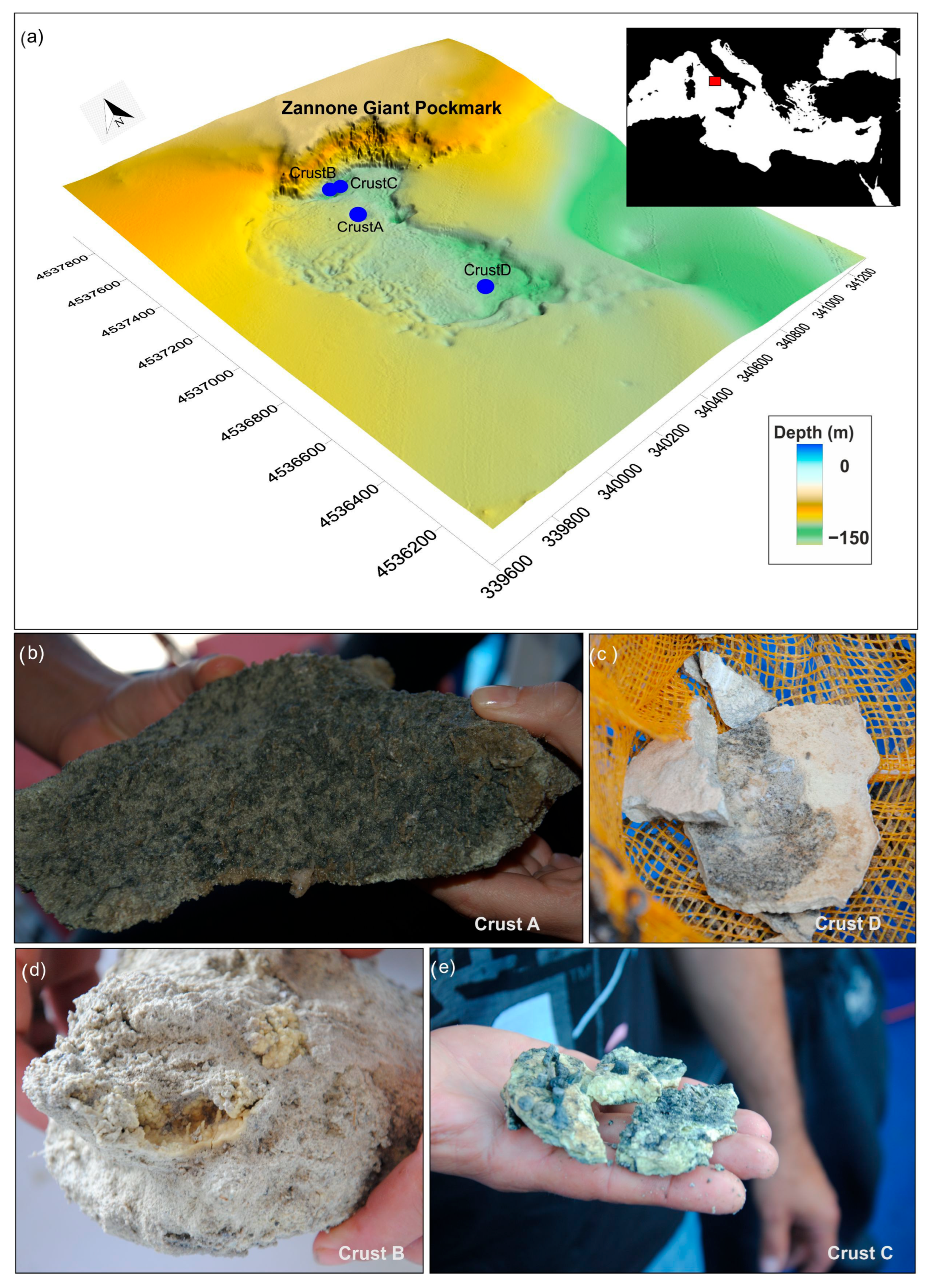
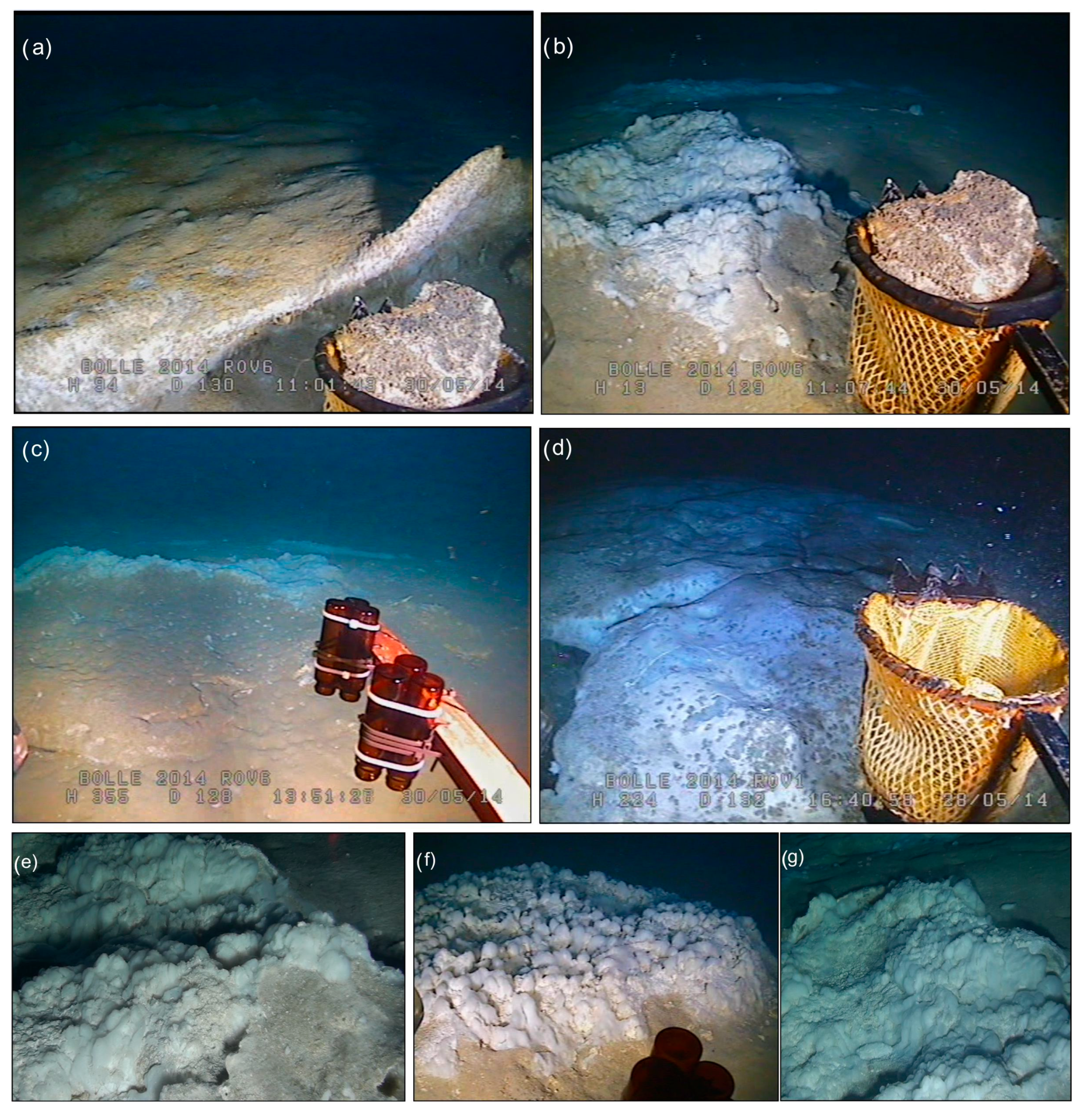
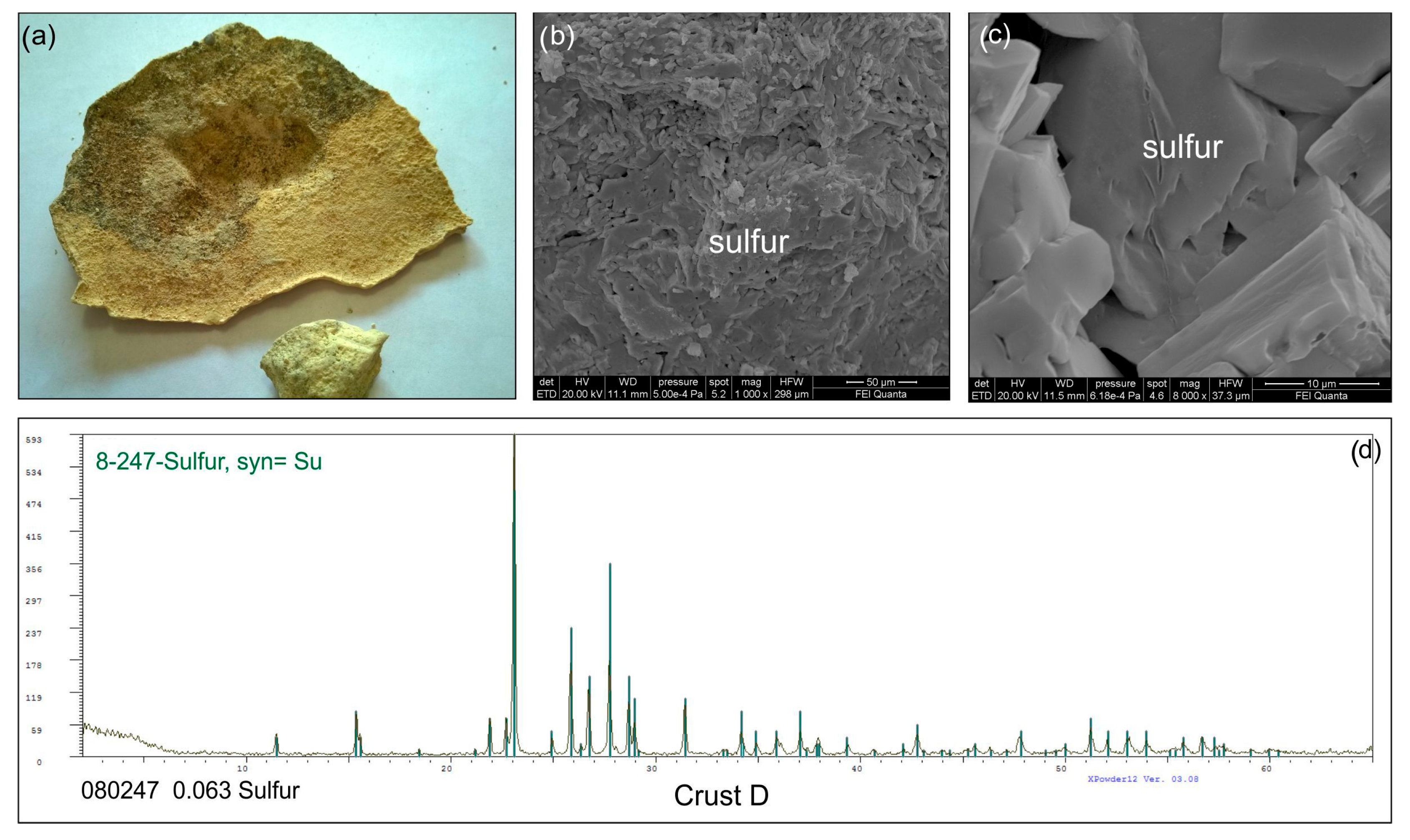
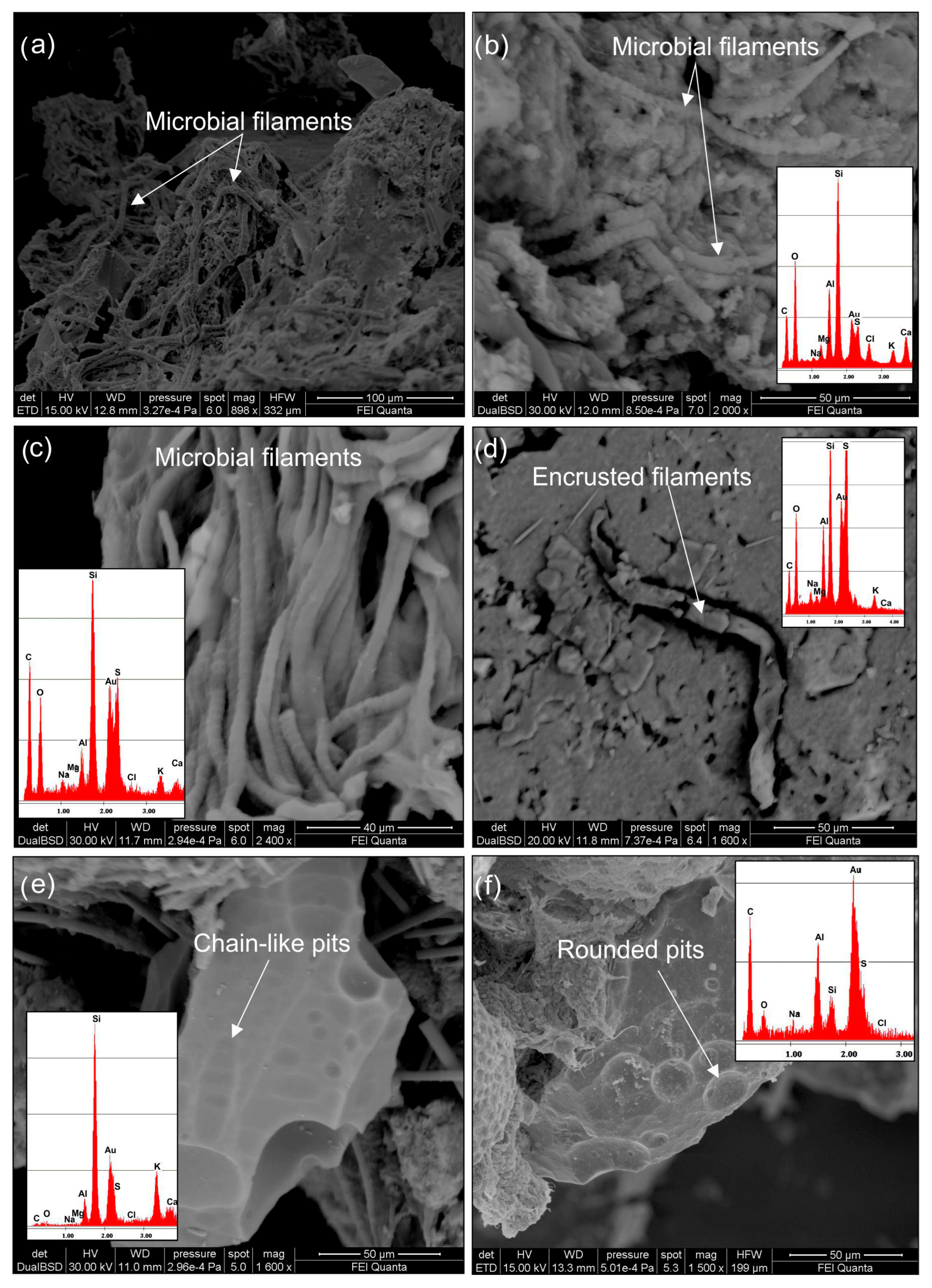
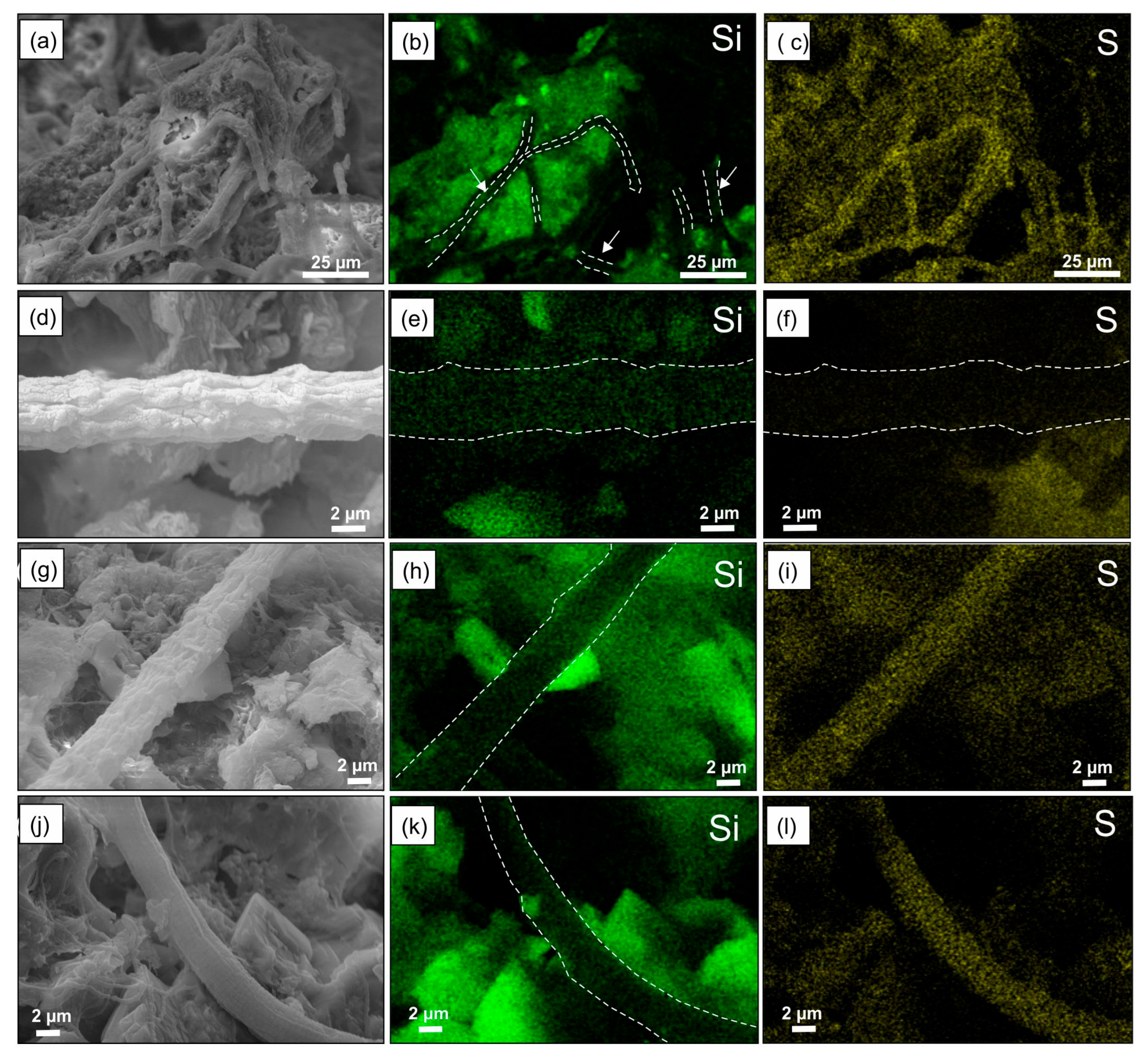
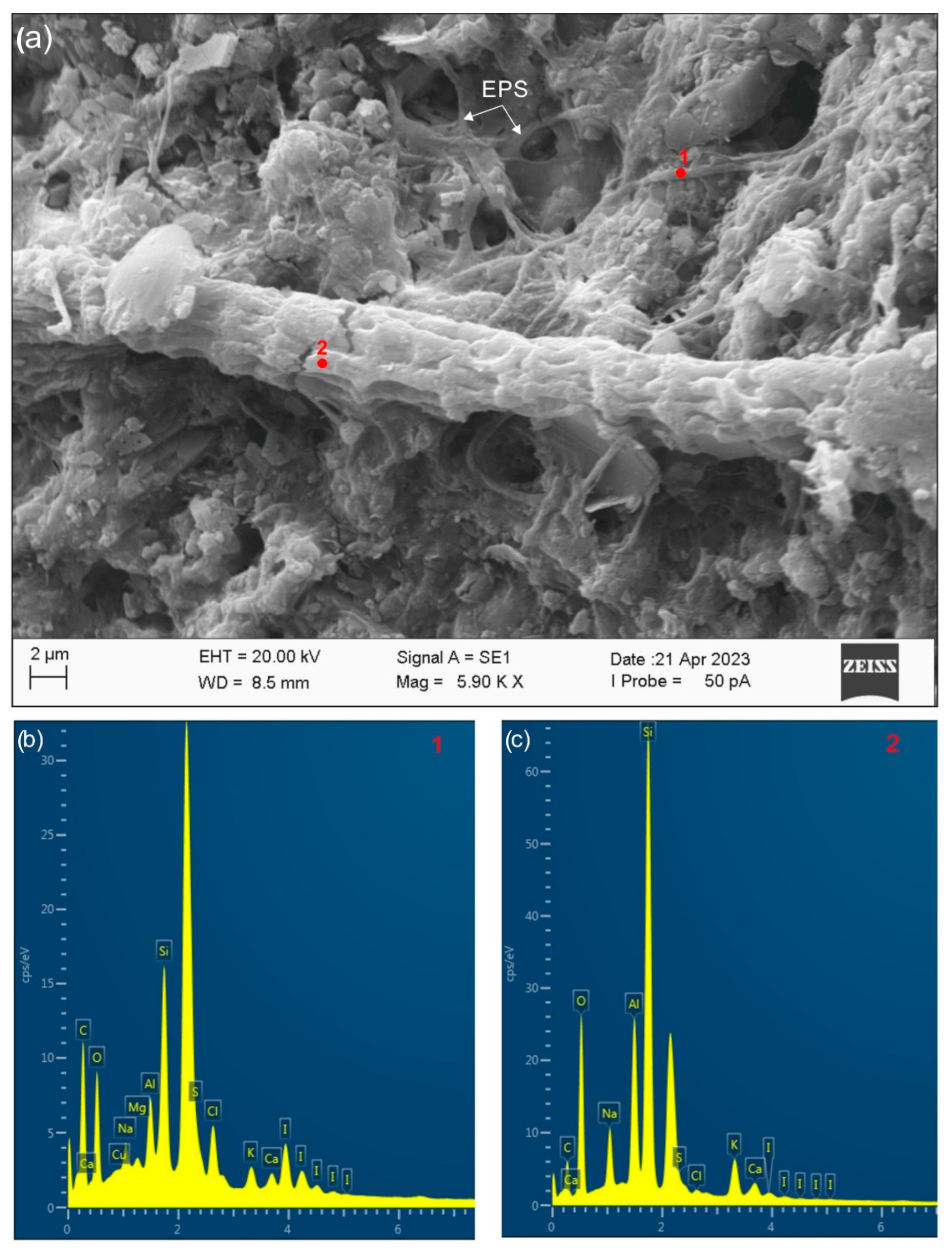
| Sample | Lat | Lon | Depth (m) | Method |
|---|---|---|---|---|
| CRUST A | 40°58′14″ N | 13°06′05″ E | 128 | ROV |
| CRUST B | 40°58′21″ N | 13°06′06″ E | 135 | Grab |
| CRUST C | 40°58′21″ N | 13°06′06″ E | 135 | Grab |
| CRUST D | 40°57′56″ N | 13°06′07″ E | 130 | ROV |
| Analyte Symbol | d34S |
| Unit Symbol | per mill |
| Crust D | −5.77‰ |
| Crust A | −6.977‰ |
| Crust C | −2.037‰ |
| Crust B | −9.827‰ |
Disclaimer/Publisher’s Note: The statements, opinions and data contained in all publications are solely those of the individual author(s) and contributor(s) and not of MDPI and/or the editor(s). MDPI and/or the editor(s) disclaim responsibility for any injury to people or property resulting from any ideas, methods, instructions or products referred to in the content. |
© 2025 by the authors. Licensee MDPI, Basel, Switzerland. This article is an open access article distributed under the terms and conditions of the Creative Commons Attribution (CC BY) license (https://creativecommons.org/licenses/by/4.0/).
Share and Cite
Ingrassia, M.; Conte, A.M.; Di Bella, L.; Perinelli, C.; Ruspandini, T.; Paciucci, M.; Martorelli, E. Silica- and Sulfur-Rich Deposits Preserving Microbial Signatures at Zannone Hydrothermal Field, Western Mediterranean Sea. Minerals 2025, 15, 794. https://doi.org/10.3390/min15080794
Ingrassia M, Conte AM, Di Bella L, Perinelli C, Ruspandini T, Paciucci M, Martorelli E. Silica- and Sulfur-Rich Deposits Preserving Microbial Signatures at Zannone Hydrothermal Field, Western Mediterranean Sea. Minerals. 2025; 15(8):794. https://doi.org/10.3390/min15080794
Chicago/Turabian StyleIngrassia, Michela, Aida Maria Conte, Letizia Di Bella, Cristina Perinelli, Tania Ruspandini, Matteo Paciucci, and Eleonora Martorelli. 2025. "Silica- and Sulfur-Rich Deposits Preserving Microbial Signatures at Zannone Hydrothermal Field, Western Mediterranean Sea" Minerals 15, no. 8: 794. https://doi.org/10.3390/min15080794
APA StyleIngrassia, M., Conte, A. M., Di Bella, L., Perinelli, C., Ruspandini, T., Paciucci, M., & Martorelli, E. (2025). Silica- and Sulfur-Rich Deposits Preserving Microbial Signatures at Zannone Hydrothermal Field, Western Mediterranean Sea. Minerals, 15(8), 794. https://doi.org/10.3390/min15080794









